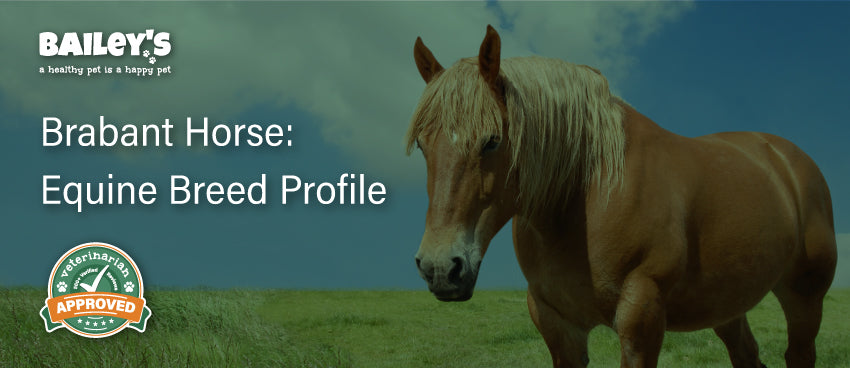Brabant Horse: Equine Breed Profile

The Brabant Horse is a remarkable equine breed with a rich history and notable presence in both work and sport. Known for its gentle temperament and incredible strength, the Brabant Horse has long been a cherished and valuable partner in various equine activities.
In this comprehensive guide, we'll explore the origin and evolution of the Brabant Horse, delve into its distinctive physical characteristics, and discuss its calm and reliable temperament. Furthermore, we will examine the care and maintenance essential for these horses, investigate their health and lifespan, and highlight their significant role in both work and sport arenas.
Table of Contents
1. Understanding the Brabant Horse Breed
1.1 Origin and History of the Brabant Horse
The Brabant Horse, also known as the Belgian Heavy Horse or Belgian Draft Horse, proudly hails from the Brabant region of Belgium. It is one of the oldest draft horse breeds in existence. Dating back to medieval times, this breed played a crucial role in agricultural work and transportation.
The Brabant Horse owes its ancestry to the massive Flemish horse breed and the indigenous Ardennes horse breed. These two breeds were selectively bred to produce what we now know as the Brabant Horse.

During World War I, the Brabant Horse played a vital role in the war effort, serving as a reliable and sturdy military mount. The breed faced a decline in the early 20th century due to mechanization, but thanks to the efforts of dedicated breeders, it made a remarkable comeback.
Today, the Brabant Horse is not only cherished for its historical significance but also valued for its versatility. It is widely used in various equestrian disciplines, including driving, logging, and agricultural work. Its gentle temperament and exceptional strength make it a favorite among horse enthusiasts and farmers alike.
1.2 Physical Characteristics of the Brabant Horse
With its powerful and muscular build, the Brabant Horse is an impressive sight to behold. It stands tall, typically reaching a height of 15 to 17 hands, with a weight ranging from 1,800 to 2,500 pounds. Its robust frame is accentuated by a broad chest, strong shoulders, and substantial hindquarters.
The Brabant Horse is renowned for its distinctive appearance. It has a short, compact body, a sturdy neck, and a refined head with kind, expressive eyes. Its large, well-muscled legs end in hardy hooves that are capable of handling the strain of heavy work.
Traditionally, the Brabant Horse came in a variety of solid colors, including bay, chestnut, and roan. However, today, the breed exhibits various coat colors, adding to its versatility and allure.
Related Equine Article🐴:
Roan Horse Coat Color in Equines: A Comprehensive GuideNot only is the Brabant Horse physically impressive, but it also possesses remarkable endurance and stamina. Its muscular physique allows it to pull heavy loads with ease, making it an invaluable asset in agricultural settings and other demanding tasks.
Furthermore, the Brabant Horse's temperament is often described as docile and willing. It is known for its calm and gentle nature, which makes it an ideal choice for novice riders and those seeking a reliable and trustworthy equine partner.
In addition to its physical attributes, the Brabant Horse is admired for its intelligence and willingness to work. It is a quick learner and can be easily trained to perform a wide range of tasks. Its eagerness to please and its strong work ethic make it a valuable asset in various equestrian disciplines.
Overall, the Brabant Horse is a breed that combines strength, beauty, and versatility. Its rich history and remarkable characteristics make it a beloved breed among horse enthusiasts worldwide.
2. The Temperament of the Brabant Horse
2.1 Personality Traits
The Brabant Horse is renowned for its calm and docile nature. It is gentle, even-tempered, and highly trainable, making it an excellent choice for both novice and experienced horse owners. This breed possesses a natural willingness to please, exhibiting a remarkable work ethic and loyalty to its human companions.
One of the most fascinating aspects of the Brabant Horse's temperament is its ability to form deep emotional bonds with its caretakers. This breed has a remarkable capacity for empathy and understanding, often displaying a strong sense of connection with the humans it interacts with. This unique trait not only makes the Brabant Horse a reliable and trustworthy companion but also contributes to its overall suitability for various equestrian activities.
Despite its massive size, the Brabant Horse has a remarkably gentle disposition. Its calm and patient nature allows it to handle stressful situations with grace and composure. Whether it's navigating through a crowded showground or encountering unfamiliar obstacles on a trail ride, the Brabant Horse's steady temperament ensures a sense of security and confidence for both horse and rider.
2.2 Suitability for Families and Children
The Brabant Horse's gentle temperament and patient nature make it an excellent choice for families and children. This breed's calmness and reliability provide a safe and enjoyable experience for riders of all ages and skill levels.
When it comes to children, the Brabant Horse truly shines as a remarkable teacher and friend. Its kind and forgiving nature allows young riders to learn and grow in a supportive environment. The Brabant Horse becomes a patient mentor, guiding children through the basics of horsemanship and instilling in them a sense of responsibility and empathy towards animals.
Furthermore, the Brabant Horse's large size and sturdy build instill confidence in younger riders. This breed's solid and dependable physique ensures a sense of security, allowing children to develop their equestrian skills with ease. Whether it's a gentle walk in the pasture or a thrilling gallop through an open field, the Brabant Horse adapts to the needs and abilities of its young riders, creating cherished memories and fostering a lifelong love for horses.
3. Care and Maintenance of a Brabant Horse
The Brabant Horse, known for its strength, versatility, and gentle nature, requires proper care and maintenance to ensure its health and well-being. In addition to providing a balanced diet and regular exercise, there are several other factors to consider when caring for this magnificent breed.
3.1 Dietary Requirements
Proper nutrition is essential to maintain the health and well-being of a Brabant Horse. A balanced diet should consist of high-quality forage, such as hay or pasture, supplemented with grain or specialized horse feed. It is crucial to consult with a veterinarian or equine nutritionist to determine the appropriate feeding regimen based on the horse's age, activity level, and overall health.
Brabant Horses have a robust appetite and require ample amounts of food to meet their energy needs. Feeding smaller, frequent meals throughout the day helps prevent digestive issues and promotes optimal nutrient absorption. Additionally, providing access to mineral blocks or supplements ensures the horse receives essential vitamins and minerals.
Related Articles for CBD for Horses Health and Wellness🐴:
🌿🐎 CBD for Horses: This is What You Need to Know🌿🐎 Top Health Benefits of Hemp Pellets for Horses
🌿🐎 CBD Oil for Horses: Efficiency and Application
Explore more articles related to CBD for horses' health and wellness.
In addition to a well-rounded diet, access to clean, fresh water at all times is essential to keep the Brabant Horse properly hydrated. Horses can consume a significant amount of water daily, and dehydration can lead to serious health problems. Regularly cleaning and refilling water troughs or buckets is necessary to maintain water quality.
3.2 Exercise and Training Needs
The Brabant Horse is a working breed with a natural inclination for physical activity. Regular exercise is vital to the horse's well-being, both physically and mentally. Daily turnout in a spacious paddock or pasture allows the horse to graze, roam, and socialize with fellow equines.
Under saddle, the Brabant Horse thrives in various equestrian disciplines such as dressage, driving, and jumping. Its willingness to work and eagerness to learn make it highly trainable. Consistent and patient training methods, paired with positive reinforcement, yield excellent results with this breed.
When engaging in training sessions, it is important to start with a proper warm-up to loosen the horse's muscles and prevent injuries. Gradually increase the intensity and duration of the exercise, allowing the horse to build strength and endurance over time. Regularly incorporating variety into the training routine, such as trail rides or obstacle courses, helps keep the Brabant Horse mentally stimulated and prevents boredom.
After a workout, proper cool-down and post-exercise care are essential. This includes walking the horse to gradually lower its heart rate, offering water to rehydrate, and thoroughly grooming to remove sweat and dirt. Regular hoof care, including trimming and shoeing, is also crucial to maintain the horse's soundness and prevent lameness.
Furthermore, providing the Brabant Horse with regular opportunities for social interaction is important for its overall well-being. Horses are herd animals by nature and thrive when they have the chance to interact with other horses. Whether through group turnout or organized playdates, socialization helps prevent loneliness and promotes a balanced temperament.

Caring for a Brabant Horse involves more than just providing a proper diet and regular exercise. Attention to detail, such as monitoring water intake, implementing a well-rounded training program, and ensuring socialization opportunities, is key to maintaining the health and happiness of this remarkable breed.
4. Health and Lifespan of the Brabant Horse
4.1 Common Health Issues
Like all horse breeds, the Brabant Horse is susceptible to certain health issues. However, due to its robust constitution and well-maintained breeding standards, it tends to be a relatively healthy breed.
Some common health concerns that may affect the Brabant Horse include respiratory issues, such as allergies or recurrent airway obstruction, and joint problems like arthritis. Regular veterinary check-ups, vaccinations, and proper hoof care are essential preventive measures to ensure the horse's well-being.
4.2 Average Lifespan and Quality of Life
When provided with proper care, a Brabant Horse can live a long and fulfilling life. The average lifespan of this breed ranges from 20 to 25 years, although some individuals have been known to live even longer. Regular exercise, a balanced diet, preventive veterinary care, and a safe living environment all contribute to a high-quality life for these majestic animals.
5. The Brabant Horse in Work and Sport
5.1 The Brabant Horse in FarmWork
The Brabant Horse has a rich history as a working horse in agricultural settings. Its strength, endurance, and docile temperament make it an outstanding choice for demanding farm tasks. From plowing fields to hauling heavy loads, the Brabant Horse is a reliable partner, greatly contributing to the success of farm operations worldwide.
Despite the advent of modern machinery, the Brabant Horse's contribution to farming continues to be valued. Its presence evokes a sense of nostalgia and tradition, and many enthusiasts appreciate its ability to connect with the land and perform tasks with minimal environmental impact.
5.2 The Brabant Horse in Equestrian Sports
While the Brabant Horse excels in labor-intensive agricultural work, it also shines in various equestrian sports. Its natural athleticism, combined with its trainable nature and gentle disposition, make it an excellent competitor in disciplines such as carriage driving, dressage and even show jumping.
The Brabant Horse's versatility allows it to adapt to different riding styles and excel in both individual and team competitions. Its power and grace captivate audiences, making it a favorite choice for those seeking a unique and impressive equestrian partner.
6. Conclusion
With its remarkable history, impressive physical characteristics, gentle temperament, and versatility in work and sport, the Brabant Horse offers a captivating equine experience. Whether in the fields, participating in equestrian sports, or being a reliable companion for families and children, this breed continues to make its mark in the world of horses. Its enduring legacy is a testament to the dedication of breeders and the enduring bond between humans and horses.
These products have not been evaluated by the FDA and are not intended to diagnose, treat, cure, or prevent any disease.











